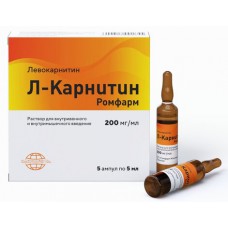Expiration date: 05/2029
Form of release
Solution for intravenous and intramuscular administration of 200 mg/ml 5.0 ml in ampoules - 5 pcs per pack.
The dosage form
is a colorless transparent solution.
Composition
1 ml of the drug contains:
active ingredient: levocarnitine - 200.0 mg;
auxiliary substances: 1 M hydrochloric acid solution - up to pH 6.3 - 6.5, water for injection - up to 1.00 ml.
Pharmacotherapeutic group
metabolic agent
Pharmacodynamics
Levocarnitine is a drug for correcting metabolic processes; it has metabolic, anabolic, antihypoxic and antithyroid effects, activates fat metabolism, stimulates regeneration, and increases appetite. Levocarnitine is a natural substance related to vitamins of group B. It is a cofactor of metabolic processes that ensure the maintenance of coenzyme A (CoA) activity.
Reduces basal metabolism, slows down the breakdown of protein and carbohydrate molecules. It promotes the penetration through mitochondrial membranes and the cleavage of long-chain fatty acids (palmitic acid, etc.) to form acetyl-CoA (necessary to ensure the activity of pyruvate carboxylase during gluconeogenesis, the formation of ketone bodies, the synthesis of choline and its esters, oxidative phosphorylation and the formation of adenosine triphosphate (ATP)). Mobilizes fat (the presence of 3 labile methyl groups) from fat depots. Competitively displacing glucose, it includes a fatty acid metabolic shunt, the activity of which is not limited by oxygen (unlike aerobic glycolysis), and therefore the drug is effective in conditions of acute hypoxia (including the brain) and other critical conditions.
It causes a slight depression of the central nervous system (CNS), increases the secretion and enzymatic activity of digestive juices (gastric and intestinal), improves food absorption.
Reduces excess body weight and reduces fat content in skeletal muscles.
Increases the threshold of resistance to physical activity, reduces the degree of lactate acidosis and restores performance after prolonged physical exertion. At the same time, it promotes economical consumption of glycogen and increases its reserves in the liver and muscles.
It has a neurotrophic effect, inhibits apoptosis, restricts the affected area and restores the structure of the nervous tissue.
Normalizes protein and fat metabolism, increased basal metabolism in thyrotoxicosis (being a partial thyroxine antagonist); restores the alkaline reserve of the blood.
Pharmacokinetics
After intravenous administration, it disappears from the blood after 3 hours. It easily penetrates into the liver and myocardium, more slowly into the muscles.
It is excreted by the kidneys mainly in the form of acyl esters (more than 80% in 24 hours).
Indications
Rompharm L-carnitine is used as part of complex therapy for acute hypoxic conditions (acute cerebral hypoxia, ischemic stroke, transient ischemic attack). The drug is prescribed in acute, subacute and recovery periods of cerebral circulation disorders. It is used for dyscirculatory encephalopathy and various traumatic and toxic brain lesions, in the recovery period after surgical interventions.
Rompharm L-Carnitine is indicated for primary and secondary carnitine deficiency, including in patients with chronic renal failure undergoing hemodialysis; for cardiomyopathy, coronary heart disease (angina pectoris, acute myocardial infarction, postinfarction conditions), hypoperfusion due to cardiogenic shock and other disorders of myocardial metabolism.
Contraindications
Hypersensitivity to levocarnitine or to other components of the drug, pregnancy and lactation.
With caution, the drug should be prescribed for diabetes mellitus.
Pregnancy and breastfeeding
L-Carnitine Rompharm should not be used during pregnancy and lactation.
Method of administration and dosage
Rompharm L-Carnitine is administered intravenously, slowly or in a jet (2-3 min) or intramuscularly. Before intravenous administration, the contents of the ampoule are dissolved in 100-200 ml of solvent (0.9% sodium chloride solution or 5% dextrose (glucose) solution).
In acute disorders of cerebral circulation, 1 g / day is prescribed for 3 days, and then 0.5 g / day for 7 days. After 10-12 days, repeated courses are possible for 3-5 days.
When prescribing the drug in the subacute and recovery period, with dyscirculatory encephalopathy and various brain lesions, carnitine deficiency, patients are given levocarnitine solution at the rate of 0.5-1 g / day intravenously (drip, jet) or intramuscularly (2-3 times a day) without dilution for 3-7 days. If necessary, a repeat course is prescribed after 12-14 days.
Intravenous administration, slowly (2-3 min.) is prescribed for secondary carnitine deficiency during hemodialysis - 2 g once (after the procedure); for acute myocardial infarction, acute heart failure - 3-5 g / day, divided into 2-3 doses in the first 2-3 days, followed by a 2-fold dose reduction; for cardiogenic shock - 3-5 g/ day, divided into 2-3 doses until the patient comes out of shock. Next, they switch to oral levocarnitine.
Side effects
Mild symptoms of myasthenia gravis were observed only in uremic patients taking levocarnitine. Allergic reactions.
With rapid administration (80 drops / min or more), pain may occur along the vein, passing with a decrease in the rate of administration.
Overdose
There is no data on toxicity in case of levocarnitine overdose. Drug tolerance should be monitored during the first week of administration and after each dose increase.
In case of overdose, treatment is prescribed to maintain vital functions, symptomatic treatment.
Drug interaction
Glucocorticoids promote the accumulation of levocarnitine in tissues (except the liver), other anabolics enhance the effect.
Special instructions
L-Carnitine Rompharm is not addictive, because levocarnitine is an endogenous substance.
Increased glucose uptake when L-Carnitine Rompharm is administered to diabetic patients receiving insulin or oral hypoglycemic drugs may cause hypoglycemia. For this reason, during treatment with L-Carnitine Rompharm, blood glucose levels should be constantly monitored in this category of patients for immediate correction of the dosage regimen of hypoglycemic drugs.
Prolonged use of levocarnitine in high doses in patients with severe renal impairment may cause an increase in the concentration of potentially toxic metabolites, trimethylamine and trimethylamine-N-oxide, as these metabolites are usually excreted in the urine. In this case, urine, breath, and sweat discharge have an unpleasant odor.
If any of the side effects listed in the instructions worsen, or you notice any other side effects not listed in the instructions, tell your doctor.
Influence on the ability to drive motor vehicles and manage mechanisms
The drug does not affect the ability to drive vehicles and other potentially dangerous activities.
Storage temperature
from 2℃ to 25℃



